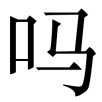Difference between revisions of "Language/Mandarin-chinese/Vocabulary/吗-ma"
< Language | Mandarin-chinese | Vocabulary
Jump to navigation
Jump to search
(→Uses) Tags: Mobile edit Mobile web edit |
|||
| Line 22: | Line 22: | ||
==Other particles== | ==Other particles== | ||
How to make the difference between 吧 (ba) and 吗 (ma)?: [[Language/Chinese-mandarin/Vocabulary/吧-ba|The particle 吧 (ba)]] | How to make the difference between 吧 (ba) and 吗 (ma)?: [[Language/Chinese-mandarin/Vocabulary/吧-ba|The particle 吧 (ba)]] | ||
==How to write?== | |||
<youtube>5sFtes2KsN0</youtube> | |||
[[Category:Chinese-Characters]] | [[Category:Chinese-Characters]] | ||
[[Category:Chinese-Particles]] | [[Category:Chinese-Particles]] | ||
Revision as of 16:07, 24 December 2016
吗 (ma), the interrogative final particle.
Uses
吗 (ma) is one of the most common particles in Chinese. A particle goes on the end of a sentense.
It is used to ask questions.
The particle 吗 is placed on the end of question which can only be answered with a “yes” or a “no”.
Examples
- 你饿吗 Nǐ è ma?
Are you hungry?
- 你要去上海吗 Nǐ yào qù Shànghǎi ma?
Are you going to go to Shanghai?
- 你是中国人吗 Nǐ shì zhōngguórén ma?
Are you Chinese?
Other particles
How to make the difference between 吧 (ba) and 吗 (ma)?: The particle 吧 (ba)
